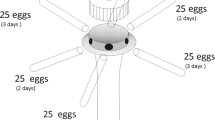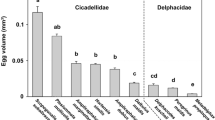Abstract
Laboratory studies assessing the degree of suitability of the mealybugs Planococcus ficus (Signoret), Planococcus citri (Risso) and Pseudococcus calceolariae (Maskell), towards the Sicilian ecotype of the encyrtid parasitoid Anagyrus sp. nr. pseudococci were carried out. All three species of mealybugs were shown to encapsulate the eggs of the encyrtid; however, significant differences were revealed among them in rates of encapsulation and/or superparasitism. The level of aggregate encapsulation and effective encapsulation of the parasitoid eggs by P. citri (74.95 ± 0.87 and 60.19 ± 1.70, respectively) was significantly higher than that recorded for P. ficus (aggregate encapsulation = 58.43 ± 0.83 and effective encapsulation = 31.31 ± 1.55) and significantly lower than the values found in Ps. calceolariae (93.99 ± 0.97 and 88.61 ± 2.03, respectively). As such, rates of parasitism were significantly lower for P. ficus compared with both P. citri and Ps. calceolariae. The two latter species of mealybugs showed similar rates of parasitism by A. sp. nr. pseudococci. Moreover, a significantly higher rate of superparasitism was found for Ps. calceolariae compared with both P. citri and P. ficus, whereas no significant differences were found between the two species of Planococcus for this parameter.
Similar content being viewed by others
References
Bartlett, B. R. (1978). Pseudococcidae. In C. P. Clausen (Ed.), Introduced parasites and predators of arthropod pests and weeds: A world review (pp. 137–170). Washington, DC: Agricultural Research Service, United States Department of Agriculture.
Bertin, S., Cavalieri, V., Graziano, C., & Bosco, D. (2010). Survey of mealybug (Hemiptera: Pseudococcidae) vectors of Ampelovirus and Vitivirus in vineyards of northwestern Italy. Phytoparasitica, 38, 401–409.
Blumberg, D. (1990). Host resistance: Encapsulation of parasites. In D. Rosen (Ed.), The armored scale insects, their biology, natural enemies and control (Vol. B, pp. 221–228). Amsterdam, the Netherlands: Elsevier Science Publishers BV.
Blumberg, D. (1997). Parasitoid encapsulation as a defense mechanism in the Coccoidea (Homoptera) and its importance in biological control. Biological Control, 8, 225–236.
Blumberg, D., Franco, J. C., Suma, P., Russo, A., & Mendel, Z. (2001). Parasitoid encapsulation in mealybugs (Hemiptera: Pseudococcidae) as affected by the host–parasitoid association and superparasitism. Bollettino di Zoologia Agraria e di Bachicoltura, 33, 385–395.
Blumberg, D., Klein, M., & Mendel, Z. (1995). Response by encapsulation of four mealybug species (Homoptera, Pseudococcidae) to parasitization by Anagyrus pseudococci. Phytoparasitica, 23, 157–163.
Blumberg, D., & Van Driesche, R. G. (2001). Encapsulation rates of three Encyrtid parasitoids by three mealybug species (Homoptera: Pseudococcidae) found commonly as pests in commercial greenhouses. Biological Control, 22, 191–199.
Cabaleiro, C., & Segura, A. (1997). Field transmission of grapevine leafroll associated virus 3 (GLRaV-3) by the mealybug Planococcus citri. Plant Disease, 81, 283–287.
Chong, J. H., & Oetting, R. D. (2007). Specificity of Anagyrus sp. nov. nr. sinope and Leptomastix dactylopii for six mealybug species. Biocontrol, 52, 289–308.
Compere, H. (1939). Mealybugs and their insect enemies in South America. University of California Publications in Entomology, 7, 57–73.
Daane, K. M., Bentley, W. J., Walton, V. M., Malakar-Kuenen, R., Yokota, G. Y., Millar, J. G., et al. (2006). New controls investigated for vine mealybug. California Agriculture, 60, 31–38.
Dalla Montà, L., Duso, C., & Malagnini, V. (2001). Current status of scale insects (Hemiptera: Coccoidea) in the Italian vineyards. Bollettino di Zoologia Agrararia e Bachicoltura, 33, 343–350.
Driesche, R. G., Bellotti, A., Herrera, C. J., & Castillo, J. A. (1986). Encapsulation rates of two encyrtid parasitoids by two Phenacoccus spp. of cassava mealybugs in Colombia. Entomologia Experimentalis et Applicata, 42, 79–82.
Franco, J. C., Silva, E. B., Cortegano, E., Campos, L., Branco, M., Zada, A., et al. (2008). Kairomonal response of the parasitoid Anagyrus spec. nov. near pseudococci to the sex pheromone of the vine mealybug. Entomologia Experimentalis et Applicata, 126, 122–130.
Franco, J. C., Silva, E. B., Fortuna, T., Cortegano, E., Branco, M., Suma, P., et al. (2011). Vine mealybug sex pheromone increases citrus mealybug parasitism by Anagyrus sp. near pseudococci (Girault). Biological Control, 58, 230–238.
Franco, J. C., Suma, P., Silva, E. B., Blumberg, D., & Mendel, Z. (2004). Management strategies of mealybug pests of citrus in Mediterranean countries. Phytoparasitica, 32, 507–522.
Güleç, G., Kilinçer, A. N., Kaydan, M. B., & Ülgentürk, S. (2007). Some biological interactions between the parasitoid Anagyrus pseudococci (Girault) (Hymenoptera: Encyrtidae) and its host Planococcus ficus (Signoret) (Hemiptera: Coccoidea: Pseudococcidae). Journal of Pest Science, 80, 43–49.
La Torre, I., Suma, P., & Russo, A. (2009). Sulla presenza di Anagyrus sp. nov. near pseudococci in Sicilia. Atti Congresso Nazionale Italiano di Entomologia, 22, 341.
Mansour, R., Mazzeo, G., La Pergola, A., Grissa Lebdi, K., & Russo, A. (2011). A survey of scale insects (Hemiptera: Coccoidea) and tending ants in Tunisian vineyards. Journal of Plant Protection Research, 51, 197–203.
Mills, N. J., & Wajnberg, E. (2008). Optimal foraging behavior and efficient biological control methods. In E. Wajnberg, C. Bernstein, & J. van Alphen (Eds.), Behavioral ecology of insect parasitoids—from theoretical approaches to field applications (pp. 3–30). Oxford, UK: Blackwell Publishing Ltd.
Noyes, J. S. (2010). Universal Chalcidoidea Database. http://www.nhm.ac.uk/chalcidoids.
Noyes, J. S., & Hayat, M. (1994). Oriental mealybug parasitoids of the Anagyrini (Hymenoptera: Encyrtidae). Wallingford, UK: CABI.
Pellizzari, G., & Germain, G. F. (2010). Scales (Hemiptera, Superfamily Coccoidea). Chapter 9.3. BioRisk, 4, 475–510.
Petersen, C. L., & Charles, J. G. (1997). Transmission of grapevine leafroll-associated closteroviruses by Pseudococcus longispinus and P. calceolariae. Plant Pathology, 46, 509–515.
Sagarra, L. A., Peterkin, D. D., Vincent, C., & Stewart, R. K. (2000). Immune response of the hibiscus mealybug, Maconellicoccus hirsutus Green (Homoptera: Pseudococcidae), to oviposition of the parasitoid Anagyrus kamali Moursi (Hymenoptera: Encyrtidae). Journal of Insect Physiology, 46, 647–653.
Sforza, R., Boudon-Padieu, E., & Greif, C. (2003). New mealybug species vectoring grapevine leafroll-associated viruses-1 and −3 (GLRaV-1 and −3). European Journal of Plant Pathology, 109, 975–981.
StatSoft Inc. (2003). Statistica (data analysis software system) version 6. Tulsa, OK, USA: StatSoft, Inc. http://www.statsoft.com.
Trjapitzin, S. V., & Trjapitzin, V. A. (1999). Parasites of mealybugs (Homoptera, Pseudococcidae) on cultivated grapes in Argentina, with description of a new species of the genus Aenasius Walker (Hymenoptera, Encyrtidae). Entomological Review, 79, 386–390.
Triapitsyn, S. V., Gonzáles, D., Vickerman, D. B., Noyes, J. S., & White, E. B. (2007). Morphological, biological and molecular comparisons among the different geographical populations of Anagyrus pseudococci (Hymenoptera: Encyrtidae), with notes on Anagyrus dactylopii. Biological Control, 41, 14–24.
Wajnberg, E., & Ris, N. (2009). Parasitism and biological control. In F. Thomas, J.-F. Guégan, & F. Renaud (Eds.), Ecology and evolution of parasitism (pp. 107–127). Oxford, UK: Oxford University Press.
Wakgari, W. M., & Giliomee, J. H. (2003). Natural enemies of three mealybug species (Hemiptera: Pseudococcidae) found on citrus and effects of some insecticides on the mealybug parasitoid Coccidoxenoides peregrinus (Hymenoptera: Encyrtidae) in South Africa. Bulletin of Entomological Research, 93, 243–254.
Walton, V. M., Krüger, K., Saccaggi, D. L., & Millar, I. M. (2009). A survey of scale insects (Sternorryncha: Coccoidea) occurring on table grapes in South Africa. Journal of Insect Science, 9, 47.
Williams, D. J. (1985). Australian mealybugs. Publication 953, British Museum (Natural History), London, UK.
Acknowledgments
Our thanks are expressed to three anonymous reviewers for their comments and suggestions on an earlier version of the manuscript.
Author information
Authors and Affiliations
Corresponding author
Rights and permissions
About this article
Cite this article
Suma, P., Mansour, R., Russo, A. et al. Encapsulation rates of the parasitoid Anagyrus sp. nr. pseudococci, by three mealybug species (Hemiptera: Pseudococcidae). Phytoparasitica 40, 11–16 (2012). https://doi.org/10.1007/s12600-011-0199-8
Received:
Accepted:
Published:
Issue Date:
DOI: https://doi.org/10.1007/s12600-011-0199-8




